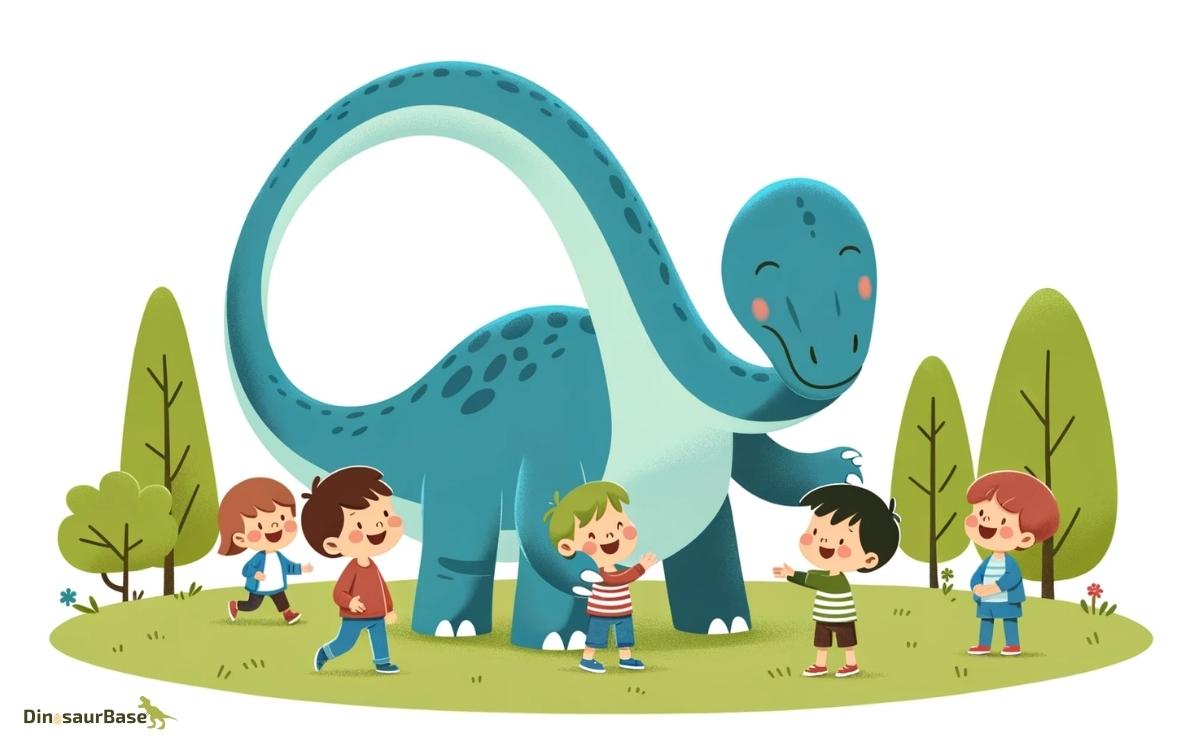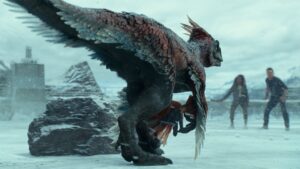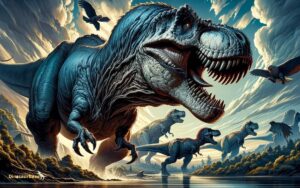Which Dinosaur Is Friendly? Stegosaurus!
The sociable Hadrosaurs, often referred to as ‘duck-billed dinosaurs,’ provide a fascinating glimpse into the world of friendly dinosaurs. Their fossil records suggest they lived in large groups, indicating a level of social interaction that could point to a more gentle nature.
As we explore the different facets of dinosaur life, from their eating habits to their social structures, the question arises:
Were these ancient giants the gentle giants of their time, or does their friendliness extend beyond our current understanding?
This question invites further exploration into the lives of these remarkable creatures, offering insights into a world millions of years in the past.


Key Takeaway
Unveiling Herbivorous Giants
Amidst the diverse Mesozoic landscapes, colossal herbivorous dinosaurs thrived, playing a pivotal role in their ecosystems. These giants, including the long-necked sauropods and the armored ankylosaurs, adapted to a variety of ecological niches.
Their diets primarily consisted of vegetation, which they efficiently processed with specialized teeth and digestive systems.
The sauropods, for instance, reached monumental sizes, possibly due to their highly efficient, fermentative digestion, allowing them to extract maximum nutrients from their plant-based diets.
Meanwhile, ankylosaurs’ robust body armor protected them against predators, showcasing an evolutionary response to the constant threat of carnivorous dinosaurs.
This intricate balance of herbivory and predation sculpted the Mesozoic era’s dynamic ecosystems, demonstrating the herbivorous giants’ essential role in maintaining ecological equilibrium.
The Sociable Hadrosaurs
Hadrosaurs, often referred to as ‘duck-billed dinosaurs,’ frequently exhibited complex social behaviors, living and migrating in large, organized groups.
These herbivorous creatures thrived during the Late Cretaceous period, and their social structures are thought to have played a significant role in their survival and evolutionary success.
- Social Structure: Evidence suggests hadrosaurs lived in hierarchical societies, similar to those of modern elephants, which could have facilitated coordinated movements and defense strategies against predators.
- Communication: They likely used vocalizations to communicate, with their large, hollow crests acting as resonance chambers to produce a variety of sounds.
- Parental Care: Fossil findings indicate that hadrosaurs might’ve exhibited parental care, with adults and juveniles found together, suggesting a protective behavior towards their offspring.
Their gregarious nature underscores the complexity of dinosaur social behaviors, offering fascinating insights into their lives millions of years ago.
Triceratops: Gentle Horned Beasts
Triceratops, often depicted as the iconic horned behemoth of the Late Cretaceous, exhibited behaviors that suggest a complex, social lifestyle not unlike that of their contemporaries, the hadrosaurs.
Fossil evidence, including trackways and nesting sites, indicates that Triceratops lived in herds, a behavior that implies a certain level of social interaction and cooperation.
The structure of their horns and frills, while initially interpreted as purely defensive weapons against predators like Tyrannosaurus rex, also likely played a role in social signaling and hierarchical disputes within the group.
This suggests that Triceratops wasn’t just a solitary creature defending itself from threats, but a social animal, engaging in complex interactions with its own kind, further challenging the stereotype of dinosaurs as solitary behemoths.
Diplodocus: Nature’s Peaceful Giants
Diplodocus, renowned for its immense size, represents another facet of dinosaur behavior, showcasing a gentle, herbivorous lifestyle that highlights the diversity of prehistoric ecosystems.
Despite their colossal stature, Diplodocus were peaceful giants, primarily feeding on plants. This feeding behavior suggests a low-stress lifestyle, browsing on ferns and conifers, rather than competing aggressively for food resources.
- Diplodocus had long necks, enabling them to reach high and low vegetation, which minimized competition with other species.
- Their peg-like teeth were well-suited for stripping rather than chewing vegetation, indicating a diet of soft plant materials.
- Tail whip marks on fossilized bones suggest they might’ve used their tails defensively, but not for hunting or fighting, reinforcing their peaceful nature.
Understanding Diplodocus adds depth to our perception of dinosaur communities as complex ecosystems with a range of behaviors and interactions.
Stegosaurus: A Slow-Moving Friend
While exploring the peaceful giants of the dinosaur world, it’s essential to consider the Stegosaurus, a species that epitomizes the slow-moving yet fascinating aspects of dinosaur behavior.
This herbivorous behemoth, known for its distinctive row of bony plates along its back and spiked tail, offers a unique glimpse into the life of Jurassic flora grazers.
Despite its cumbersome appearance, Stegosaurus possessed a brain size comparable to that of a dog, suggesting it relied heavily on instinctual behaviors to navigate its environment and interact with fellow dinosaurs.
| Feature | Description | Significance |
|---|---|---|
| Body Structure | Large, bony plates and spiked tail | Defense and thermoregulation |
| Brain Size | Comparable to a dog’s | Suggests reliance on instinct |
| Diet | Herbivorous | Peaceful, slow-moving lifestyle |
| Habitat | Late Jurassic Period | Flourished in prehistoric forests |
| Social Behavior | Likely lived in herds | Implies a degree of social interaction |
The Playful Nature of Parasaurolophus
Parasaurolophus, known for its distinctive long, curved crest, exhibited behaviors suggesting a playful and social nature among its peers.
Paleontologists infer these characteristics from fossilized evidence and the dinosaur’s anatomical structures, which hint at a life spent engaging with others of its kind.
The playful nature of Parasaurolophus can be further understood through:
- Social interaction: Evidence suggests they lived in herds, facilitating social bonds and cooperative behaviors.
- Vocal communication: Their unique crests likely played a role in producing sounds, indicating complex communication that could include playful interactions.
- Gregarious behavior: Fossil tracks imply group activities, possibly including playful chasing or congregating in favored spots, akin to modern animals engaging in social play.
These points emphasize Parasaurolophus’s capacity for playfulness, underpinning their friendly disposition within their prehistoric environment.
Ankylosaurus: Armored but Harmless
Despite its formidable armor, Ankylosaurus led a predominantly peaceful existence, using its heavy plating more for defense than aggression.
This Late Cretaceous herbivore sported a unique combination of features designed to deter predators rather than confront them. Its body was covered in thick, bony plates, culminating in a large, club-like tail that served as its primary defensive weapon.
Scientific analysis of Ankylosaurus skeletal structures suggests that the dinosaur’s armor wasn’t just passive protection but could also be used to deliver powerful blows to potential threats.
However, the absence of predatory adaptations in its anatomy indicates that Ankylosaurus preferred to avoid confrontation, relying on its defensive capabilities to coexist with its contemporaries.
This evolutionary strategy highlights Ankylosaurus’s role as a gentle giant within its ecosystem, prioritizing survival through defense rather than aggression.
Understanding Dinosaur Social Structures
Numerous dinosaurs exhibited complex social behaviors, suggesting a sophisticated level of interaction within their species.
Insights into their social structures have been pieced together through fossil evidence and nesting sites, revealing a glimpse into their communal living arrangements.
- Herding Behavior: Many species, such as the Hadrosaurids, are believed to have lived in large groups, providing protection against predators and facilitating communal raising of offspring.
- Dominance Hierarchies: Evidence suggests some species, like the Ceratopsians, may have established social hierarchies, possibly determined through combat or display features.
- Communication Methods: Various dinosaurs likely used vocalizations, body language, and possibly even color changes to communicate within their social groups, enhancing their ability to coordinate and form bonds.
Understanding these social structures offers a window into the complex lives of these ancient creatures, highlighting their ability to cooperate and interact within their communities.
Maiasaura: The Good Mother Dinosaur
Building on our understanding of dinosaur social structures, the Maiasaura, known as the ‘good mother dinosaur,’ offers compelling evidence of complex parental care and social behavior in the Mesozoic era.
Studies of Maiasaura nesting grounds reveal an organized society where adults nurtured their young long after hatching. This care significantly increased the survival rates of offspring, a trait not common in reptiles but seen in birds, their modern descendants.
| Feature | Significance |
|---|---|
| Nesting Grounds | Indicates communal living and shared parenting |
| Fossilized Eggs | Shows evidence of warmth and protection |
| Growth Rings | Suggests juveniles grew under parental care |
| Bone Histology | Reveals stress patterns from nurturing behavior |
| Social Structure | Implies a complex, cooperative community |
Maiasaura’s behavior showcases the evolutionary roots of nurturing in dinosaurs, highlighting a sophisticated level of social organization.
Camarasaurus: Gentle Jumbos of Jurassic
Amidst the giants of the Jurassic period, the Camarasaurus stood out for its remarkable gentleness, shedding light on the diverse behaviors of sauropods.
This dinosaur, often mistaken for a mere behemoth, displayed characteristics that suggest a more serene disposition compared to its contemporaries.
- Herbivorous Diet: The Camarasaurus primarily fed on vegetation, which is indicative of its peaceful nature.
- Social Behavior: Evidence suggests they might’ve moved in herds, indicating a potential for social interaction and communal living.
- Physical Features: With its long neck and sturdy build, the Camarasaurus was adept at reaching high vegetation without the need for aggression or competition.
These aspects contribute to the understanding that, despite their massive size, some dinosaurs such as the Camarasaurus exhibited behaviors that align with gentleness and non-aggressiveness.
Exploring Dinosaur Communication Skills
Researchers have uncovered evidence suggesting dinosaurs used complex vocalizations to strengthen social bonds within their groups.
These vocal signals, coupled with body language, formed a nuanced system of communication that facilitated interactions among these ancient creatures.
Analyzing these communication methods offers insights into the social dynamics and behaviors of dinosaurs, revealing a sophisticated level of interaction previously underestimated.
Vocalizing Bonds
Understanding how dinosaurs communicated reveals intricate social networks facilitated by vocalizations, which played a crucial role in their survival and evolutionary success.
These vocalizations weren’t mere noises; they were complex calls that varied in frequency, amplitude, and modulation, indicating sophisticated communication skills among these ancient creatures.
Researchers suggest that these vocal signals served multiple functions:
- Establishing territory and warding off potential threats
- Coordinating group movements during migrations or while hunting
- Strengthening social bonds within packs or family units
This form of communication indicates not only a level of social organization but also a capacity for emotional expression among dinosaurs.
Their ability to vocalize bonds underscores the importance of sound in prehistoric ecosystems, acting as a precursor to the intricate communication systems observed in modern animals.
Body Language Signals
While vocalizations played a pivotal role in dinosaur communication, body language signals also offered nuanced insights into their social interactions and emotional states.
These prehistoric creatures likely used a combination of postures, gestures, and physical displays to convey a wide range of messages.
For instance, a dinosaur might’ve expanded its frill or flashed its brightly colored scales to signal availability for mating or to assert dominance.
Similarly, submissive postures such as lowering the body or avoiding direct eye contact could indicate a willingness to defer to another’s authority.
Scientists deduce these behaviors from closely examining fossilized remains and comparing them to modern animals with similar physical structures.
This comparative analysis provides a window into the complex social lives of dinosaurs, revealing that they weren’t just solitary predators or passive herbivores but engaged in rich, communicative behaviors.
Conclusion
In the ancient tapestry of prehistoric life, the contrast between the ferocious predators and the gentle giants is stark.
While the carnivorous dinos thrived on aggression, the herbivorous species like Hadrosaurs, Triceratops, and Diplodocus showcased a more harmonious existence.
These creatures, relying on complex social structures and sophisticated communication, exemplified nature’s inclination toward peaceful cohabitation.
The gentle giants, with their sheer size yet docile nature, remind us that strength doesn’t always correlate with ferocity, but often with the capacity for gentleness and cooperation.




